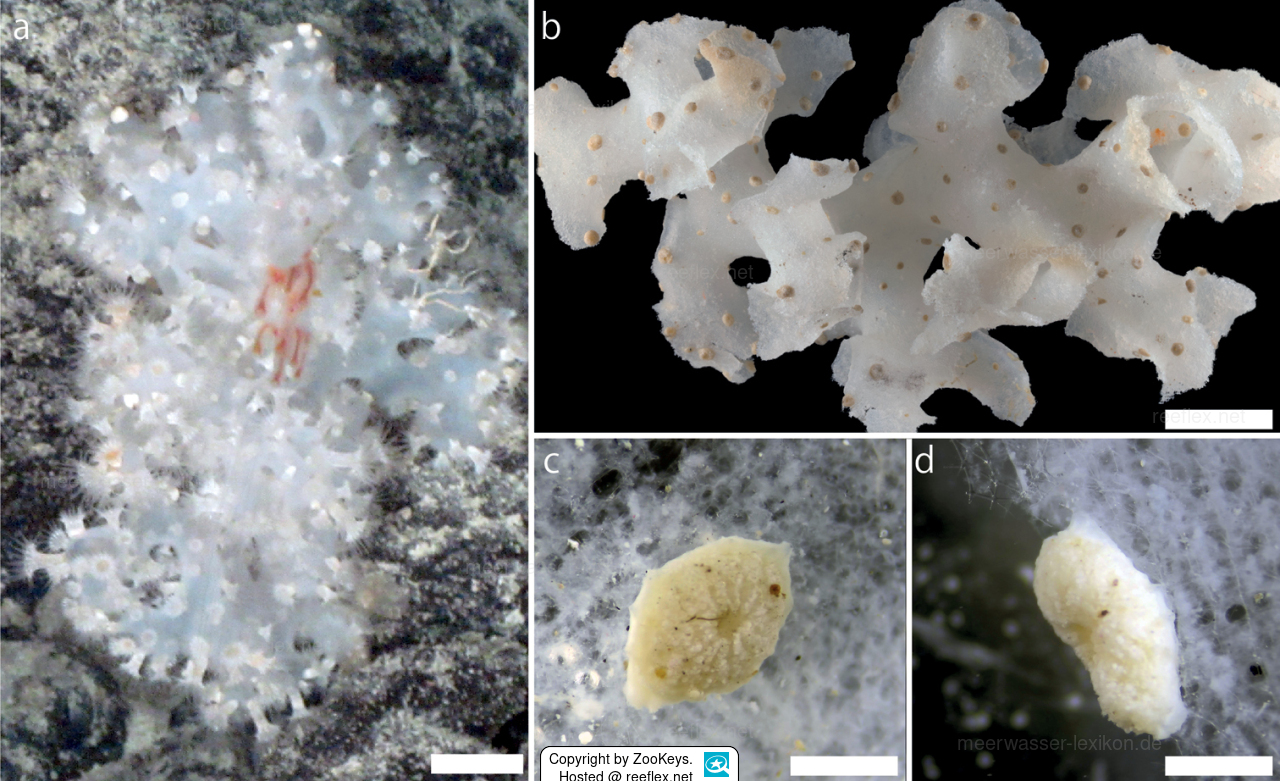Info
The holotype of the newly described deep-water crustose anemone Parachurabana shinseimaruae is from Takuyo-Daigo Seamount off southwestern Minami-Torishima Island.
It was collected from a depth of 935 meters by the research/survey vessel RV Shinsei-maru, on June 19, 2020.
The crustose anemone has 24-28 tentacles shorter than or equal to the diameter of the expanded oral disc.
Live, fully expanded polyps are approximately 1cm in height and 0.5cm in diameter.
The body column of live animals is white and/or yellowish; however, the capitulum and tentacles are transparent.
The Zoanthus species associated with the sponge host Farrea sp. (Porifera: Hexactinellida).
Comparison:
Parachurabana shinseimaruae has only been recorded on a seamount off southwestern Minami Torishima Island.
However, Parachurabana shinseimaruae may be distributed throughout the Pacific, as several specimens have been observed in Australian waters associated with Farreid sponges. Although Parachurabana shinseimaruae is morphologically similar to Vitrumanthus schrieri, Parachurabana shinseimaruae and Vitrumanthus schrieri can be distinguished on the basis of marginal musculature (cteniform endodermal marginal musculature vs. cyclic transitional marginal musculature).
In addition, Parachurabana shinseimaruae can be distinguished from Churabana kuroshioae by the size of the polyps (0.5 - 1.0 mm height and 0.5 - 3.0 mm diameter vs. 3.0 - 4.0 mm height and 2.8 - 4.0 mm diameter).
Etymology:
The genus name "Parachurabana" alludes to its morphological similarities with Churabana. The prefix "para" is a Greek word meaning "similar".
Note: Churabana is a Japanese black tea (https://okinawaclip.com/en/detail/1616).
Churabana translates as "pretty flower."
Species epithet:
The species is named after the RV Shinsei-maru because the type specimens were collected from this ship.
Literature reference:
Kise H, Nishijima M, Iguchi A, Minatoya J, Yokooka H, Ise Y, Suzuki A (2023).
A new hexactinellid-sponge-associated zoantharian (Porifera, Hexasterophora) from the northwestern Pacific Ocean.
ZooKeys 1156: 71-85. https://doi.org/10.3897/zookeys.1156.96698
This is an open access article distributed under the terms of the Creative Commons Attribution License (CC BY 4.0), which permits unrestricted use, distribution, and reproduction in any medium, provided the original author and source are credited.
It was collected from a depth of 935 meters by the research/survey vessel RV Shinsei-maru, on June 19, 2020.
The crustose anemone has 24-28 tentacles shorter than or equal to the diameter of the expanded oral disc.
Live, fully expanded polyps are approximately 1cm in height and 0.5cm in diameter.
The body column of live animals is white and/or yellowish; however, the capitulum and tentacles are transparent.
The Zoanthus species associated with the sponge host Farrea sp. (Porifera: Hexactinellida).
Comparison:
Parachurabana shinseimaruae has only been recorded on a seamount off southwestern Minami Torishima Island.
However, Parachurabana shinseimaruae may be distributed throughout the Pacific, as several specimens have been observed in Australian waters associated with Farreid sponges. Although Parachurabana shinseimaruae is morphologically similar to Vitrumanthus schrieri, Parachurabana shinseimaruae and Vitrumanthus schrieri can be distinguished on the basis of marginal musculature (cteniform endodermal marginal musculature vs. cyclic transitional marginal musculature).
In addition, Parachurabana shinseimaruae can be distinguished from Churabana kuroshioae by the size of the polyps (0.5 - 1.0 mm height and 0.5 - 3.0 mm diameter vs. 3.0 - 4.0 mm height and 2.8 - 4.0 mm diameter).
Etymology:
The genus name "Parachurabana" alludes to its morphological similarities with Churabana. The prefix "para" is a Greek word meaning "similar".
Note: Churabana is a Japanese black tea (https://okinawaclip.com/en/detail/1616).
Churabana translates as "pretty flower."
Species epithet:
The species is named after the RV Shinsei-maru because the type specimens were collected from this ship.
Literature reference:
Kise H, Nishijima M, Iguchi A, Minatoya J, Yokooka H, Ise Y, Suzuki A (2023).
A new hexactinellid-sponge-associated zoantharian (Porifera, Hexasterophora) from the northwestern Pacific Ocean.
ZooKeys 1156: 71-85. https://doi.org/10.3897/zookeys.1156.96698
This is an open access article distributed under the terms of the Creative Commons Attribution License (CC BY 4.0), which permits unrestricted use, distribution, and reproduction in any medium, provided the original author and source are credited.







 ZooKeys
ZooKeys

